Eichhornia crassipes (Mart.) Solms
| Etymology | Genus | After Johann Albrecht Freidrich Eichhorn, a 19th century Prussian politician |
|---|---|---|
| Species | Thick foot; likely referring to the swollen leaf stalks | |
| Family | Pontederiaceae | |
| Synonyms | Pontederia crassipes Mart. | |
| Common Names | Water Hyacinth | |
| Status | Exotic: Naturalised | |
| Form | Climber | |
| Native Distribution | South America | |
Diagnostics:
Eichhornia crassipes is a free floating aquatic herb of about 30cm across. It consist of a rosette of leaves; each being thick, broad and waxy; and ending with a swollen, air-filled leaf stalk to help it to float. The flowers are purple and arranged along a single stalk.
Interesting Facts:
The Water Hyacinth is considered an invasive species in many countries (CABI), as it is fast growing and can propagate asexually from its stolons, forming dense mats across a water surface. This can clog waterways, and compete/block with other aquatic plants for sunlight and nutrients.
This weed was introduced to Singapore in 1893 by a resident, and became a major pest in 1975 where Kranji Reservoir was almost entirely covered by it (Tan et al., 2010). This was due to the high eutrophication in the reservoir due to the numerous pig farms along the banks. The situation was managed using mechanical removal after the farms were banned in 1977.
This aquatic plant is still actively managed in some waterbodies to reduce the water's nutrient load.
It is not known to fruit locally.

A population of Water Hyacinth trapped along Peng Siang River to reduce nutrient load (2021).

Purple inflorescence.

Leaves.

Swollen air-filled stalks.
References
CABI (n.d.). Eichhornia crassipes. Invasive Species Compendium, Centre for Agriculture and Bioscience International. https://www.cabi.org/ISC. Accessed on 12-May-2021.
Tan HTTW, LM Chou, DCJ Yeo & PKL Ng. (2010) The Natural Heritage of Singapore. 3rd edition. Pearson Education, Singapore. 323 pp.
Author: Siyang
Posted: 2021-04-30 / Modified: 2021-05-13